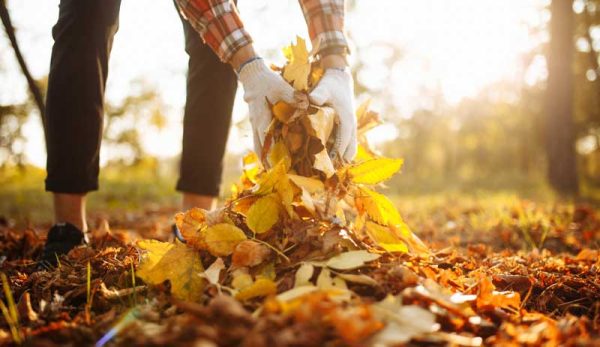
Fall leaves can seem like a nuisance, but forests thrive on their own for several reasons, the primary being fallen leaves that amend soil and protect plants. The organic matter created in leaves is full of calcium, phosphorus, magnesium and potassium. So instead of bagging up fallen leaves this autumn, follow these methods to capitalize on the free garden amendments lying around your yard.
Shred Fall Leaves for Mulch
Run piles of fall leaves through chippers, choppers and mulchers. It’s even possible to mow leaves to shred.
Pile the shredded leaves 2 to 4 inches deep around plants, avoiding crowns. The mulch will help plants retain and repel water, suppress weeds and decompose into nitrogen to feed the plant.
Make Leaf Mold for Soil Conditioning
Leaf mold results from piles of fall leaves decomposing over time. It can happen naturally where you bypass raking, but if you plan to keep your yard tidy through the fall and winter you will need to designate leaf mold areas. Leaf mold breaks down to act as a soil conditioner, helping the soil retain more water. Leaf molds are also attractive habitats to beneficial insects such as earthworms.
To create a leaf mold pile, simply pile fall leaves in a low-lying area that won’t allow the leaves to easily blow away. Add leaves to a trash bag with a few vent slits, or create a three-wall shelter like a compost bin to coral the leaves. Once piled, spray down the pile with water, thoroughly dampening the grouping. Make sure there is moisture in the pile at all times to speed up the decomposition, and add water when necessary.
No other matter will need to be added through the process. The fungal process will take effect and create its magic.
Leaf mold will take 10 to 24 months to prepare thoroughly. To speed up the process you can do the following.
- Use a rake to turn it over every so often to allow air to circulate
- Place a tarp on the pile to increase moisture and humidity
- Break down the size of leaves before adding to the pile to begin the decomposing process
Once the leaf mold has reached effectiveness, you can add to your beds by tilling/turning into the top layer of soil or around plants as a mulch. Leaf mold is a great potting medium for container plants because it helps to retain water.
Add Fall Leaves to Your Compost Pile for Nutrient-Dense Compost
Leaf molds and compost piles are not the same things.
Compost piles require nitrogen-rich greens and carbon-rich browns to create life-giving nutrients for plants. Leaf molds produce soil conditioner, not compost. Leaves are a great source of the carbon-rich browns needed to create “gardeners’ gold”. If you have gardened for any amount of time, you’ve likely heard the benefits of compost.
Waste not and want not are shared beliefs among gardeners. Rather than pay a lot of money in the spring (when you’d really rather buy new plants), prepare your leaves to act as key ingredients to healthy soil and a successful garden. This will save you money and feed your plants and soil the way forests have been since the beginning of time.
This article about using fall leaves to feed your soil was written for Hobby Farms magazine. Click here to subscribe.




